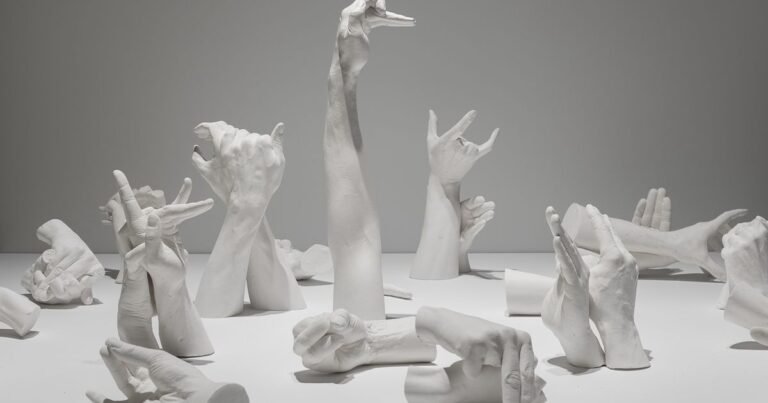An LED billboard affixed to the facade of EMST reports on local events from the perspective of Athens’s animal inhabitants. Instead of stock reports, political events, or war coverage, this unconventional news ticker broadcasts phenomena from the lives of the animals and plants around the museum. It highlights natural cycles like bird migration, beetles emerging from underground, or spiders devouring their webs—occurrences that shape seasonal fluctuations, yet remain largely overlooked by the humans living alongside them.
This outdoor work by Marcus Coates, entitled Today in Athens… (2025), initiates the shift in attention from human narratives to the recentering of animal subjectivity that underpins Katerina Gregos’s expansive group exhibition. Featuring over two hundred works by more than sixty artists, “Why Look at Animals? A Case for the Rights of Non-Human Lives” has the scale and heft of a biennial and aligns with Gregos’s penchant for ambitious socio-political themes. The exhibition takes its title from John Berger’s canonical 1977 essay, which critiques animals’ cultural and physical marginalization within modern industrial capitalism—part of the same process, he argues, that has reduced humans to isolated productive and consuming units. Picking up where Berger left off, and building on philosophical and ethical frameworks developed by thinkers such as Peter Singer, Martha Nussbaum, and Tom Regan, Gregos’s exhibition probes our “systemic disconnection from the lives and deaths of animals.”
Extending across four floors of EMST, the show begins in the belly of the building with a dense installation of works addressing the colonial, industrial, and technological foundations of animal exploitation before gradually opening up to more poetic and speculative engagements with animal intelligence and nonhuman creativity. On the basement level of the museum, Rossella Biscotti’s Clara (2016) and Ang Siew Ching’s video High-Rise Pigs (2025) offer compelling examples of how the exhibition confronts the historical commodification of nonhuman lives. Taking the form of three pallets of handmade bricks imprinted with the form of a rhinoceros, Biscotti’s work refers to the first rhinoceros to tour European cities as an exotic marvel in the eighteenth century.
The bricks’ resemblance to gold bars and to the ballast used in colonial ships foregrounds her literal and symbolic weight—a being transformed into both a curiosity and a unit of economic value. Clara’s alienation and reduction to an object of capital and spectacle is further reinforced by the work’s olfactory element: a mound of tobacco, a substance used to tranquilize the rhinoceros for her ocean passage and performances, is situated in a large heap between the three pallets of bricks. Siew Ching’s understated video opens with a slow pan of the exterior of a 26-story slaughterhouse in China’s Hubei province—the largest industrial pig farm in the world—which towers over tracts of small homes and gardens. The artist’s voiceover describes the slaughterhouse as a “metric site” where “death is made imperceptible.” Her refusal to show graphic content—and her use of simulations, figurines, and footage of families touring the facility—does not dilute the work’s violence; rather, it sharpens it, revealing how animal suffering is sustained through a triangulation of commodification, entertainment, and ruthless efficiency.
While Biscotti and Siew Ching’s contributions stand out for their sensory restraint and conceptual precision, they are part of a broader opening suite that, at times, feels overdetermined. Works like Mark Dion’s wall of trophy portraits, Lynn Hershman Leeson’s images of genetically modified animals, Jonas Staal’s photographic history of nonhuman cosmonauts, and Sammy Baloji’s collages related to hunting and collecting all make urgent claims, yet their similar format risks dulling their critical edge. More subdued works like Igor Grubić’s Ingresso Animali Vivi (2023), which follows a stray dog as it navigates an empty slaughterhouse, more overtly center a nonhuman perspective. While Biscotti and Siew Ching explore animal suffering through a conceptual lens, Grubić’s video approaches its protagonist as a subject rather than an object, foregrounding the dog’s ingenuity, curiosity, and tenacity in navigating an architecture of exploitation.
On the upper floors, where the group show is interspersed with solo presentations of Emma Talbot and Janis Rafa, the register shifts. Talbot’s animation You Are Not the Centre (inside the animal mind) (2025) imagines the perceptual worlds of a dog, spider, deer, and a captive bird. Her protagonist moves through these different roles speculatively, asking what kinds of attention and ethics might emerge if animal consciousness were taken seriously. Rafa’s “We Betrayed the Horses” is a sensual exhibition: a pitch-dark, tiled room lit only by soft neon and pink glow from foiled windows, it recasts horseback riding as a scene of erotic domination. Through video, sculpture, and the overpowering scent of rubber and horse tack, Rafa explores the dynamics of submission, control, and intimacy between human and nonhuman animals—raising the uncomfortable question of whether a desire for closeness with nonhuman animals can ever be disentangled from possession.
Berger wrote “Why Look at Animals” well before the intersectional approach of animal studies gained institutional traction, and his critique of capitalism is not concomitant with a rethinking of the human. The so-called “animal turn” in contemporary art unfolded amidst exhibitions like Documenta 13, driven by its curator Carolyn Christov-Bakargiev’s weaving together of the theories of Karen Barad, Donna Haraway, Bruno Latour, and Susan Buck-Morss in the interest of building “a worldly alliance of cosmopolitical intra-acting and cobbled-together human and nonhuman agents,” or initiatives like Lucia Pietroiusti and Filipa Ramos’s “The Shape of a Circle in the Mind of a Fish” and exhibitions like “Ape Culture,” curated by Anselm Franke and Hila Peleg at HKW in 2015.
Such projects work towards an undoing of the divisions between nature and culture, challenging entrenched hierarchies and encouraging a more holistic understanding of coexistence and agency. “Why Look at Animals?” stands apart from these curatorial precedents through its explicit activist slant. Though the exhibition occasionally verges on didacticism, it compensates with immediacy and urgency: to look at animals today is to confront the deep structures of othering that underwrite human fantasies of exceptionalism and domination, as well as the institutions that sustain them.


